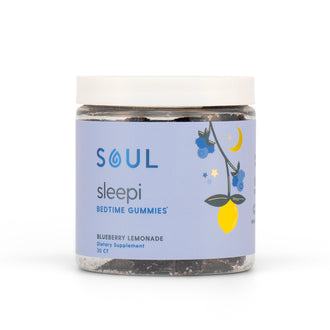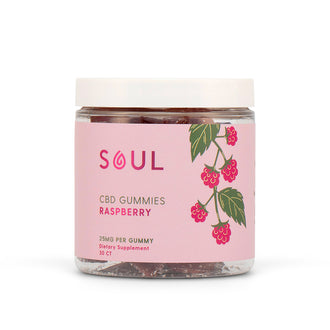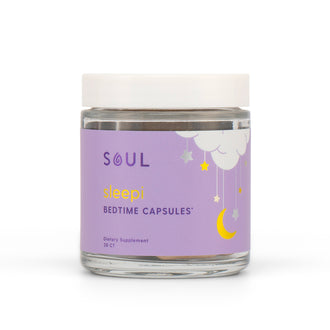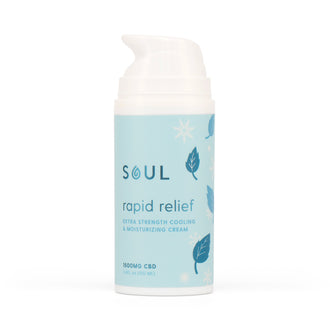
Key Takeaways:
- Broad-Spectrum Benefits: Broad-spectrum hemp offers a THC-free option with multiple cannabinoids and terpenes for enhanced wellness benefits.
- Variety of Forms: Oils, edibles, and topicals make it easy to incorporate broad-spectrum hemp into your routine.
- Legal and Safe: Legal in many areas and THC-free, it’s suitable for those seeking the benefits of hemp without psychoactive effects.
Have you ever wondered how to harness the benefits of hemp without the psychoactive effects of THC? Broad-spectrum hemp offers a solution by providing a range of cannabinoids and terpenes while eliminating THC. This allows users to experience the "entourage effect"—where multiple hemp compounds work together to enhance therapeutic benefits—without the concerns associated with THC.
At Soul, we are dedicated to delivering premium, THC-free hemp products that support your wellness journey. Our commitment to quality and transparency ensures that you receive the full benefits of broad-spectrum hemp, crafted with care and backed by rigorous testing.
In this piece, we will discuss what broad-spectrum hemp is, its various forms, key differences from other hemp extracts, legal considerations, tips for incorporating it into your routine, and how to determine if it's right for you.
What Is Broad-Spectrum Hemp?
Broad-spectrum hemp is a type of hemp extract that contains a wide range of cannabinoids, terpenes, and other beneficial compounds naturally found in the hemp plant, excluding THC. This makes it distinct from full-spectrum hemp, which includes all of these compounds along with trace amounts of THC, and CBD isolate, which contains only cannabidiol (CBD).
Broad-spectrum hemp is a popular choice for those who want to experience the potential benefits of hemp’s natural compounds without the risk of consuming THC. These benefits are often linked to the “entourage effect,” where the different cannabinoids and terpenes work synergistically to enhance their therapeutic properties.
Broad-Spectrum Hemp Vs. Full-Spectrum Hemp: Key Differences
Understanding the differences between broad-spectrum and full-spectrum hemp is essential for choosing the right product. Both extracts offer unique benefits, but their distinct compositions cater to different needs and preferences:
Full-Spectrum Hemp: Retains THC For Enhanced Effects
Full-spectrum hemp includes all the cannabinoids, terpenes, and compounds naturally found in the hemp plant, including up to 0.3% THC. This trace amount of THC contributes to the entourage effect, amplifying the potential benefits of the other compounds working together. However, its inclusion of THC can be a drawback for people who need to avoid even minimal psychoactive effects or those concerned about drug tests.
Broad-Spectrum Hemp: THC-Free With Diverse Compounds
Broad-spectrum hemp contains a wide range of cannabinoids and terpenes but is specifically processed to remove THC entirely. This makes it an appealing option for individuals who want to avoid THC while still benefiting from the entourage effect created by the remaining hemp compounds. The lack of THC also ensures it aligns with legal and workplace requirements in regions or industries with zero-tolerance policies.
Choosing Based On Your Needs
The choice between broad-spectrum and full-spectrum hemp largely depends on personal goals and requirements. Those seeking the maximum therapeutic potential of the entourage effect may lean toward full-spectrum products, while broad-spectrum hemp is ideal for individuals avoiding THC for health, safety, or legal reasons. Both offer unique advantages, making it essential to evaluate what aligns best with your lifestyle.
Forms Of Broad-Spectrum Hemp: Oils, Edibles, And More
Broad-spectrum hemp is available in a variety of forms, allowing users to choose the one that best fits their preferences and lifestyle. Here are the most common options:
- Oils and Tinctures: These are liquid extracts that can be taken sublingually (under the tongue) or added to food and drinks. They offer precise dosing and fast absorption.
- Capsules: Ideal for those who prefer a tasteless and convenient option, capsules provide pre-measured doses and are easy to incorporate into daily routines.
- Edibles: From gummies to chocolates, edibles are a flavorful and discreet way to consume broad-spectrum hemp. They often take longer to kick in but provide longer-lasting effects.
- Topicals: Lotions, balms, and creams infused with broad-spectrum hemp are applied directly to the skin. These are often used for localized relief, such as soothing sore muscles or hydrating the skin.
Each form offers unique advantages, so users can experiment to find what works best for their needs and goals.
Tips For Incorporating Broad-Spectrum Hemp Into Your Routine
Incorporating broad-spectrum hemp into your daily life can be both simple and effective, but it’s essential to approach it thoughtfully to maximize its benefits. By understanding how to dose, consume, and track your progress, you can seamlessly integrate hemp into your wellness routine. Here’s how:
Start With A Low Dose
When beginning with broad-spectrum hemp, it’s important to start small. A low dose allows your body to adjust while helping you monitor how it affects you. Gradually increase the amount over time until you find the right balance that meets your specific wellness needs.
Choose The Right Form
The form of broad-spectrum hemp you choose can significantly impact its effectiveness. For quicker results, tinctures and oils are ideal as they are absorbed rapidly under the tongue. If you prefer convenience or longer-lasting effects, edibles or capsules may be better suited to your lifestyle.
Pair With Food Or Drinks
Enhancing your hemp experience can be as easy as mixing it with your favorite food or beverage. Adding tinctures to smoothies, coffee, or tea makes consumption more enjoyable while also boosting absorption when paired with fatty foods. This approach is particularly helpful for those who dislike the taste of hemp oils.
Establish A Routine
Consistency is key when it comes to seeing the full benefits of broad-spectrum hemp. Incorporating it into your daily schedule, such as in the morning for energy or at night for relaxation, helps ensure you experience its effects regularly. Making it a habit enhances its long-term value in your wellness routine.
Track Your Results
Keeping a journal is a helpful way to monitor your experience with broad-spectrum hemp. Record your dosage, form of consumption, and the effects you notice over time. This process allows you to identify patterns and refine your usage for better outcomes.
Consult A Professional
If you’re unsure about how to start or worried about potential interactions, seeking professional advice is a smart step. A healthcare provider can guide you on appropriate dosages and address any concerns, ensuring a safe and effective integration of hemp into your wellness plan.
Broad-Spectrum Hemp And Legal Considerations
Broad-spectrum hemp products are widely used, but understanding their legal status is crucial before making a purchase. While hemp-derived products enjoy federal legality in many places, nuances in state and international laws may impact how you can use or access them. Below are key aspects of the legal landscape surrounding broad-spectrum hemp:
Federal Legality Of Broad-Spectrum Hemp
Under the 2018 Farm Bill, hemp-derived products, including broad-spectrum hemp, are federally legal in the United States as long as they contain less than 0.3% THC. This legal framework allows manufacturers to produce and sell hemp extracts nationwide, but it requires strict adherence to the THC threshold. Products must undergo testing to verify compliance, ensuring they do not exceed this federal limit.
State-Specific Hemp Regulations
Although broad-spectrum hemp is federally legal, individual states have the authority to impose stricter rules on its use and sale. In some states, even THC-free products may face regulatory hurdles due to broader restrictions on hemp or CBD. Consumers should familiarize themselves with their local laws, as legal definitions and permitted products can vary significantly between regions.
International Hemp Laws And Travel Restrictions
When traveling internationally, it is important to recognize that laws governing hemp products vary from country to country. Some nations may prohibit all cannabis-derived products, regardless of THC content, while others allow broad-spectrum hemp if certain conditions are met. Always research the destination’s policies on hemp to avoid legal complications at customs or during your stay.
THC-Free Claims And Product Labeling
Broad-spectrum hemp products are typically marketed as THC-free, but trace amounts may still remain due to the extraction process. To ensure compliance with laws and personal preferences, look for products tested by third-party labs to confirm the absence of THC. Transparent labeling and certifications can also guarantee that the product meets legal and quality standards.
Is Broad-Spectrum Hemp Right For You?
Choosing broad-spectrum hemp involves considering various factors, including your wellness goals, preferences, and lifestyle. Below are several key aspects to explore in determining whether this type of hemp extract suits your needs:
Your Need For THC-Free Products
Broad-spectrum hemp is an excellent choice for individuals who want to avoid THC due to professional, legal, or personal reasons. Whether you're concerned about drug tests or simply prefer to steer clear of THC entirely, broad-spectrum products provide the benefits of cannabinoids and terpenes without the psychoactive compound. It allows users to enjoy hemp’s therapeutic potential with peace of mind.
Desire For The Entourage Effect
One of the unique features of broad-spectrum hemp is its ability to deliver the entourage effect—a synergistic interaction between cannabinoids and terpenes. This effect enhances the overall benefits of the product, making it appealing for those seeking a more comprehensive experience. Without THC, you still gain a potent combination of hemp's natural compounds for wellness.
Sensitivity To THC Or Full-Spectrum Products
If you've experienced adverse reactions to THC or dislike the effects of full-spectrum hemp, broad-spectrum may be a more suitable alternative. Some users find full-spectrum products too potent or unsettling due to the presence of THC, even in small amounts. Broad-spectrum offers a balanced solution, retaining many of hemp’s benefits while eliminating potential THC-related concerns.
Experimentation And Finding The Right Fit
Trying broad-spectrum hemp can be part of discovering which hemp extract works best for your body and lifestyle. If CBD isolate feels too limited or full-spectrum seems overwhelming, broad-spectrum strikes a middle ground. Many people find it an ideal choice after experimenting with other forms of hemp.
Final Thoughts
Broad-spectrum hemp is a versatile and effective way to experience the natural benefits of the hemp plant without THC. It combines multiple cannabinoids and terpenes to enhance its potential effects, making it a balanced option for stress relief, improved focus, or general wellness. With a variety of forms available—such as oils, edibles, and topicals—it can easily fit into your daily routine. Understanding its unique features, legal considerations, and differences from other hemp extracts allows you to make an informed choice about whether it suits your needs. By starting with a manageable dose, choosing high-quality products, and consulting a professional if necessary, broad-spectrum hemp can become a valuable addition to a mindful and healthy lifestyle.
Read Also:
- Exploring Natural Relief: Evaluating The Benefits Of CBD And THC For Anxiety
- Unraveling The Enticing World Of THC: Benefits And Uses Explored
- Full-Spectrum Edibles: Everything You Need To Know
Frequently Asked Questions About Broad-Spectrum Hemp
What is the difference between broad-spectrum hemp and CBD isolate?
Broad-spectrum hemp contains multiple cannabinoids and terpenes, while CBD isolate contains only pure cannabidiol (CBD). This makes broad-spectrum hemp a better option for those seeking a more comprehensive hemp experience without THC. CBD isolate, on the other hand, is ideal for those wanting CBD in its purest form.
Can broad-spectrum hemp make you feel high?
No, broad-spectrum hemp cannot make you feel high because it contains no THC, the psychoactive compound in cannabis. It focuses on delivering therapeutic benefits without any intoxicating effects. This makes it suitable for anyone who wishes to avoid THC completely.
How is broad-spectrum hemp made THC-free?
Broad-spectrum hemp undergoes an additional extraction process to remove all detectable THC. Advanced filtration techniques ensure the retention of other beneficial compounds like cannabinoids and terpenes. These steps ensure a THC-free product while maintaining its holistic properties.
Is broad-spectrum hemp suitable for pets?
Yes, broad-spectrum hemp can be beneficial for pets, especially for managing stress, joint issues, or overall wellness. Ensure you choose pet-specific formulations with appropriate dosages. Always consult a veterinarian before giving hemp products to your pets.
How long does it take for broad-spectrum hemp to work?
The time it takes for effects to be felt depends on the form used—oils and vapes work within minutes, while edibles and capsules may take 30–90 minutes. Factors like metabolism, body weight, and dosage also influence onset time. Experimenting with forms and doses can help determine what works best for you.
Can I use broad-spectrum hemp daily?
Yes, broad-spectrum hemp can be safely used daily as part of your wellness routine. Many users find it helps with consistent benefits like stress relief or improved focus over time. Consult your healthcare provider for tailored advice, especially if you’re taking other medications.
How do I store broad-spectrum hemp products?
Store broad-spectrum hemp products in a cool, dark place away from direct sunlight and heat to maintain their potency. Sealed containers help prevent air and moisture exposure. Proper storage ensures a longer shelf life and optimal effectiveness.
Are there any age restrictions for using broad-spectrum hemp?
In most regions, you must be at least 18 or 21 years old to purchase hemp products. These age limits are based on local laws and regulations. Always verify legal requirements in your area before buying.
Does broad-spectrum hemp show up on a drug test?
Broad-spectrum hemp should not trigger a positive drug test because it is THC-free. However, some products may contain trace amounts of THC due to improper processing, so it’s essential to choose third-party tested brands. For complete peace of mind, consult with your employer or testing agency.
What should I look for in a high-quality broad-spectrum hemp product?
Look for third-party lab testing to verify purity, cannabinoid content, and the absence of THC. Reputable brands will also disclose their hemp source and extraction methods. Always review product labels for transparency and certifications.
Sources:
- McPartland, J. M., MacDonald, C., Young, M., Grant, P. S., Furkert, D. P., & Glass, M. (2017). Affinity and Efficacy Studies of Tetrahydrocannabinolic Acid A at Cannabinoid Receptor Types One and Two. Cannabis and Cannabinoid Research, 2(1), 87–95. https://doi.org/10.1089/can.2016.0032
- Mechoulam, R., Ben-Zvi, Z., Yagnitinsky, B., & Shani, A. (1969). A new tetrahydrocannabinolic acid. Tetrahedron Letters, 10(28), 2339–2341. https://doi.org/10.1016/s0040-4039(01)88158-2
- Nadal, X., del Río, C., Casano, S., Palomares, B., Ferreiro-Vera, C., Navarrete, C., Sánchez-Carnerero, C., Cantarero, I., Bellido, M. L., Meyer, S., Morello, G., Appendino, G., & Muñoz, E. (2017). Tetrahydrocannabinolic acid is a potent PPARγ agonist with neuroprotective activity. British Journal of Pharmacology, 174(23), 4263–4276. https://doi.org/10.1111/bph.14019
- Gaston, T. E., & Friedman, D. (2017). Pharmacology of cannabinoids in the treatment of epilepsy. Epilepsy & Behavior, 70, 313–318. https://doi.org/10.1016/j.yebeh.2016.11.016






